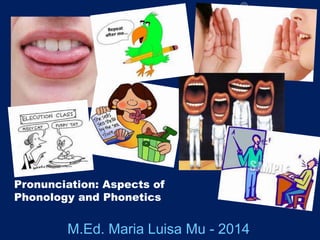
Aspects of phonetics and phonology in pronunciation
- 1. Pronunciation: Aspects of Phonology and Phonetics M.Ed. Maria Luisa Mu - 2014
- 3. Contents • Part 1: Aspects of Phonology and Phonetics • Part 2: Teaching Pronunciation
- 4. WHY teach pronunciation? • English is not pronounced as it is written: vowels and consonants can be pronounced in different ways and there are no accents to help you with stress • Incorrect pronunciation is one of the main reasons for breakdown in communication • The more help SS are given with their pronunciation, the more confident they feel when speaking • There’s no point in teaching SS new words or phrases if they can’t pronounce them comprehensibly • Despite many irregularities, there are also many rules which can help pronunciation. About 70% of words in English follow a regular pronunciation pattern • If SS are taught to recognize phonemic script, this will enable them to check pronunciation for themselves 4
- 6. What is Pronunciation • pronunciation-nqqulclbtejq
- 8. The Phonemic Chart • Introducing the chart and its sounds to students. • Recognizing and producing sounds • One or two-syllable words: • Produce each sound aloud • Connect the sounds with a single flow so it becomes a word. • Repeat the procedure for phrases
- 10. Sounds
- 13. How are consonants produced? • Plosives (Stops): • When a complete closure is made somewhere in the vocal tract. • Fricatives: • Produced with some obstruction but without any stop so the sound can be extended.
- 14. How are consonants produced? • Affricates: • A combination of plosives and fricatives. They begin as a plosive and then released slowly into a period of fricative noise.
- 15. The consonant system Labial Dental Alveolar Palatal Velar Plosive p, b t, d k, g Affricates ʧ ʤ Fricative f , v θ ð s, z ʃ ʒ Nasal m n Lateral l R-sound r Glides w j (w)
- 16. Classroom Task • Form two groups. One group will present the vowel sounds and their characteristics. The other group will present the consonant sounds. • Think of different ways of presenting your tasks so your students will understand how to produce the sounds.
- 17. Pronunciation issues 1. Perfection versus intelligibility 2. What students can hear versus what students can say 3. To use or not to use phonemic symbols 4. When to teach pronunciation
- 18. Teaching Pronunciation • Segmental: • Vowels, consonants and individual sounds • Suprasegmental: • stress and intonation.
- 19. Which aspect ot pronunciation? • Learner variables (age, proficiency, aptitude, learning style) • Setting variables(access to target language) • Institutional variables (experienced teachers, material) • Linguistic variables (problems according to L1) • Methodological variables (specific teaching approach)
- 20. Connected speech
- 21. Possibilities of relationship between sounds • Assimilation • Elision • Linking • Rhythm
- 22. Assimilation • Sounds modify each other when they meet. • Ex: That /t/ and /b/ book • Could you pass that book? • Final /t/ from that becomes /p/ to approximate /b/ from book • /t/ becomes /p/ before /b/ • /d/ becomes /b/ before /b/ • /n/ becomes /m/ before /m/
- 23. Elision • A sound disappears. • Ex: next day /t/ elided between /ks/ and /d/ so /nekst/ becomes /neks/ • Syllabic consonant. Ex: collect /klekt/ • It is indicated in print by an apostrophe • Examples: isn´t, I´ll, ´cause, Cap´n´Cook
- 24. Linking • When two vowel sounds meet • Linking /r/ . Ex: Her English is good . /r/ is pronounced. • Her German is good. /r/ is not pronounced. • Intrusive /r/ . Ex: I saw it.
- 25. Word Stress • Morphological: Unlike suffixes , prefixes are often stressed • Syntactic information: Some words change their stress depending on whether they are verbs or nouns (first syllable) • Compound words usually have stress in the second syllable • http://elt.oup.com/student/englishfile/upperint/c_ pronunciation/nef_upperint_stressgame?cc=pe& selLanguage=en
- 26. Sentence stress • Content words (also called 'lexical words'), namely nouns, adjectives, adverbs, and main verbs because they carry a high information load. • Function words (also called 'grammar words' or 'form words'), i.e. determiners (e.g. the, a), conjunctions (e.g. and, but), pronouns (e.g. she, them), prepositions (e.g. at, from), auxiliary verbs (e.g. do, be, can), are not stressed.
- 27. Functions of intonation • Emotional: attitude • Grammatical: questions vs. Statements • Information structure: what is known vs. what is new • Textual: larger stretches of discourse • Psychological: easier to percieve or memorize • Indexical: markers of group membership
- 28. Intonation and sentence rhtyhm • Short answers are normally stressed • Auxiliaries in echo questions used to show interest • Emphatic use of an auxiliary • So do I, Neither do I ( auxiliary is not stressed, the stress falls on the other two words • Question tags
- 29. Rhythm • Rhythm is the way a language sounds as a result of the pattern of stressed and unstressed syllables in speech. • A stress-time language has the stressed syllable in speech at more or less equal intervals. • Ring Jack soon, • Telephone Alison afterwards
- 30. Stress timing 1 2 3 4 1 and 2 and 3 and 4 1 and a 2 and a 3 and a 4 1 and then a 2 and then a 3 and then a 4
